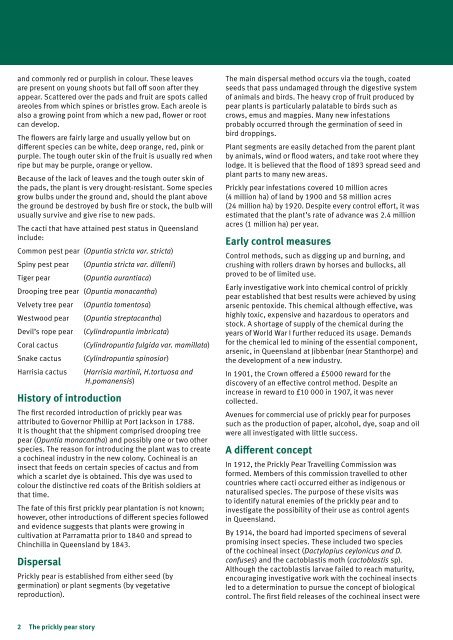The prickly pear story - Department of Primary Industries
The prickly pear story - Department of Primary Industries
The prickly pear story - Department of Primary Industries
Create successful ePaper yourself
Turn your PDF publications into a flip-book with our unique Google optimized e-Paper software.
and commonly red or purplish in colour. <strong>The</strong>se leaves<br />
are present on young shoots but fall <strong>of</strong>f soon after they<br />
ap<strong>pear</strong>. Scattered over the pads and fruit are spots called<br />
areoles from which spines or bristles grow. Each areole is<br />
also a growing point from which a new pad, flower or root<br />
can develop.<br />
<strong>The</strong> flowers are fairly large and usually yellow but on<br />
different species can be white, deep orange, red, pink or<br />
purple. <strong>The</strong> tough outer skin <strong>of</strong> the fruit is usually red when<br />
ripe but may be purple, orange or yellow.<br />
Because <strong>of</strong> the lack <strong>of</strong> leaves and the tough outer skin <strong>of</strong><br />
the pads, the plant is very drought-resistant. Some species<br />
grow bulbs under the ground and, should the plant above<br />
the ground be destroyed by bush fire or stock, the bulb will<br />
usually survive and give rise to new pads.<br />
<strong>The</strong> cacti that have attained pest status in Queensland<br />
include:<br />
Common pest <strong>pear</strong> (Opuntia stricta var. stricta)<br />
Spiny pest <strong>pear</strong><br />
Tiger <strong>pear</strong><br />
(Opuntia stricta var. dillenii)<br />
(Opuntia aurantiaca)<br />
Drooping tree <strong>pear</strong> (Opuntia monacantha)<br />
Velvety tree <strong>pear</strong><br />
Westwood <strong>pear</strong><br />
Devil’s rope <strong>pear</strong><br />
Coral cactus<br />
Snake cactus<br />
Harrisia cactus<br />
(Opuntia tomentosa)<br />
Hi<strong>story</strong> <strong>of</strong> introduction<br />
(Opuntia streptacantha)<br />
(Cylindropuntia imbricata)<br />
(Cylindropuntia fulgida var. mamillata)<br />
(Cylindropuntia spinosior)<br />
(Harrisia martinii, H.tortuosa and<br />
H.pomanensis)<br />
<strong>The</strong> first recorded introduction <strong>of</strong> <strong>prickly</strong> <strong>pear</strong> was<br />
attributed to Governor Phillip at Port Jackson in 1788.<br />
It is thought that the shipment comprised drooping tree<br />
<strong>pear</strong> (Opuntia monacantha) and possibly one or two other<br />
species. <strong>The</strong> reason for introducing the plant was to create<br />
a cochineal industry in the new colony. Cochineal is an<br />
insect that feeds on certain species <strong>of</strong> cactus and from<br />
which a scarlet dye is obtained. This dye was used to<br />
colour the distinctive red coats <strong>of</strong> the British soldiers at<br />
that time.<br />
<strong>The</strong> fate <strong>of</strong> this first <strong>prickly</strong> <strong>pear</strong> plantation is not known;<br />
however, other introductions <strong>of</strong> different species followed<br />
and evidence suggests that plants were growing in<br />
cultivation at Parramatta prior to 1840 and spread to<br />
Chinchilla in Queensland by 1843.<br />
Dispersal<br />
Prickly <strong>pear</strong> is established from either seed (by<br />
germination) or plant segments (by vegetative<br />
reproduction).<br />
<strong>The</strong> main dispersal method occurs via the tough, coated<br />
seeds that pass undamaged through the digestive system<br />
<strong>of</strong> animals and birds. <strong>The</strong> heavy crop <strong>of</strong> fruit produced by<br />
<strong>pear</strong> plants is particularly palatable to birds such as<br />
crows, emus and magpies. Many new infestations<br />
probably occurred through the germination <strong>of</strong> seed in<br />
bird droppings.<br />
Plant segments are easily detached from the parent plant<br />
by animals, wind or flood waters, and take root where they<br />
lodge. It is believed that the flood <strong>of</strong> 1893 spread seed and<br />
plant parts to many new areas.<br />
Prickly <strong>pear</strong> infestations covered 10 million acres<br />
(4 million ha) <strong>of</strong> land by 1900 and 58 million acres<br />
(24 million ha) by 1920. Despite every control effort, it was<br />
estimated that the plant’s rate <strong>of</strong> advance was 2.4 million<br />
acres (1 million ha) per year.<br />
Early control measures<br />
Control methods, such as digging up and burning, and<br />
crushing with rollers drawn by horses and bullocks, all<br />
proved to be <strong>of</strong> limited use.<br />
Early investigative work into chemical control <strong>of</strong> <strong>prickly</strong><br />
<strong>pear</strong> established that best results were achieved by using<br />
arsenic pentoxide. This chemical although effective, was<br />
highly toxic, expensive and hazardous to operators and<br />
stock. A shortage <strong>of</strong> supply <strong>of</strong> the chemical during the<br />
years <strong>of</strong> World War I further reduced its usage. Demands<br />
for the chemical led to mining <strong>of</strong> the essential component,<br />
arsenic, in Queensland at Jibbenbar (near Stanthorpe) and<br />
the development <strong>of</strong> a new industry.<br />
In 1901, the Crown <strong>of</strong>fered a £5000 reward for the<br />
discovery <strong>of</strong> an effective control method. Despite an<br />
increase in reward to £10 000 in 1907, it was never<br />
collected.<br />
Avenues for commercial use <strong>of</strong> <strong>prickly</strong> <strong>pear</strong> for purposes<br />
such as the production <strong>of</strong> paper, alcohol, dye, soap and oil<br />
were all investigated with little success.<br />
A different concept<br />
In 1912, the Prickly Pear Travelling Commission was<br />
formed. Members <strong>of</strong> this commission travelled to other<br />
countries where cacti occurred either as indigenous or<br />
naturalised species. <strong>The</strong> purpose <strong>of</strong> these visits was<br />
to identify natural enemies <strong>of</strong> the <strong>prickly</strong> <strong>pear</strong> and to<br />
investigate the possibility <strong>of</strong> their use as control agents<br />
in Queensland.<br />
By 1914, the board had imported specimens <strong>of</strong> several<br />
promising insect species. <strong>The</strong>se included two species<br />
<strong>of</strong> the cochineal insect (Dactylopius ceylonicus and D.<br />
confuses) and the cactoblastis moth (cactoblastis sp).<br />
Although the cactoblastis larvae failed to reach maturity,<br />
encouraging investigative work with the cochineal insects<br />
led to a determination to pursue the concept <strong>of</strong> biological<br />
control. <strong>The</strong> first field releases <strong>of</strong> the cochineal insect were<br />
2 <strong>The</strong> <strong>prickly</strong> <strong>pear</strong> <strong>story</strong>

















